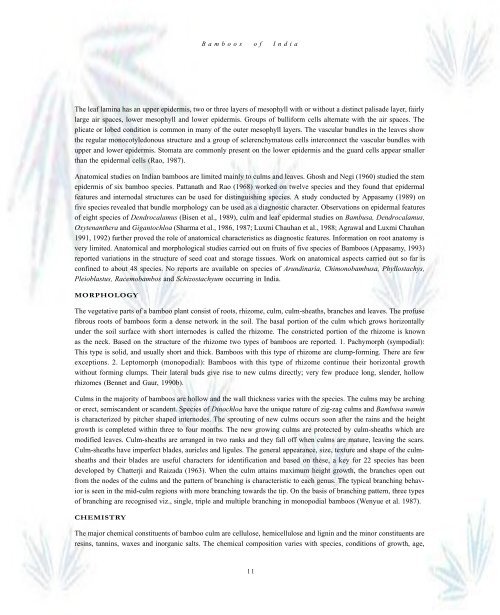You also want an ePaper? Increase the reach of your titles
YUMPU automatically turns print PDFs into web optimized ePapers that Google loves.
Bamboos of India<br />
The leaf lamina has an upper epidermis, two or three layers of mesophyll with or without a distinct palisade layer, fairly<br />
large air spaces, lower mesophyll and lower epidermis. Groups of bulliform cells alternate with the air spaces. The<br />
plicate or lobed condition is common in many of the outer mesophyll layers. The vascular bundles in the leaves show<br />
the regular monocotyledonous structure and a group of sclerenchymatous cells interconnect the vascular bundles with<br />
upper and lower epidermis. Stomata are commonly present on the lower epidermis and the guard cells appear smaller<br />
than the epidermal cells (Rao, 1987).<br />
Anatomical studies on Indian bamboos are limited mainly to culms and leaves. Ghosh and Negi (1960) studied the stem<br />
epidermis of six bamboo species. Pattanath and Rao (1968) worked on twelve species and they found that epidermal<br />
features and internodal structures can be used for distinguishing species. A study conducted by Appasamy (1989) on<br />
five species revealed that bundle morphology can be used as a diagnostic character. Observations on epidermal features<br />
of eight species of Dendrocalamus (Bisen et al., 1989), culm and leaf epidermal studies on Bambusa, Dendrocalamus,<br />
Oxytenanthera and Gigantochloa (Sharma et al., 1986, 1987; Luxmi Chauhan et al., 1988; Agrawal and Luxmi Chauhan<br />
1991, 1992) further proved the role of anatomical characteristics as diagnostic features. Information on root anatomy is<br />
very limited. Anatomical and morphological studies carried out on fruits of five species of Bamboos (Appasamy, 1993)<br />
reported variations in the structure of seed coat and storage tissues. Work on anatomical aspects carried out so far is<br />
confined to about 48 species. No reports are available on species of Arundinaria, Chimonobambusa, Phyllostachys,<br />
Pleioblastus, Racemobambos and Schizostachyum occurring in India.<br />
MORPHOLOGY<br />
The vegetative parts of a bamboo plant consist of roots, rhizome, culm, culm-sheaths, branches and leaves. The profuse<br />
fibrous roots of bamboos form a dense network in the soil. The basal portion of the culm which grows horizontally<br />
under the soil surface with short internodes is called the rhizome. The constricted portion of the rhizome is known<br />
as the neck. Based on the structure of the rhizome two types of bamboos are reported. 1. Pachymorph (sympodial):<br />
This type is solid, and usually short and thick. Bamboos with this type of rhizome are clump-forming. There are few<br />
exceptions. 2. Leptomorph (monopodial): Bamboos with this type of rhizome continue their horizontal growth<br />
without forming clumps. Their lateral buds give rise to new culms directly; very few produce long, slender, hollow<br />
rhizomes (Bennet and Gaur, 1990b).<br />
Culms in the majority of bamboos are hollow and the wall thickness varies with the species. The culms may be arching<br />
or erect, semiscandent or scandent. Species of Dinochloa have the unique nature of zig-zag culms and Bambusa wamin<br />
is characterized by pitcher shaped internodes. The sprouting of new culms occurs soon after the rains and the height<br />
growth is completed within three to four months. The new growing culms are protected by culm-sheaths which are<br />
modified leaves. Culm-sheaths are arranged in two ranks and they fall off when culms are mature, leaving the scars.<br />
Culm-sheaths have imperfect blades, auricles and ligules. The general appearance, size, texture and shape of the culmsheaths<br />
and their blades are useful characters for identification and based on these, a key for 22 species has been<br />
developed by Chatterji and Raizada (1963). When the culm attains maximum height growth, the branches open out<br />
from the nodes of the culms and the pattern of branching is characteristic to each genus. The typical branching behavior<br />
is seen in the mid-culm regions with more branching towards the tip. On the basis of branching pattern, three types<br />
of branching are recognised viz., single, triple and multiple branching in monopodial bamboos (Wenyue et al. 1987).<br />
CHEMISTRY<br />
The major chemical constituents of bamboo culm are cellulose, hemicellulose and lignin and the minor constituents are<br />
resins, tannins, waxes and inorganic salts. The chemical composition varies with species, conditions of growth, age,<br />
11


